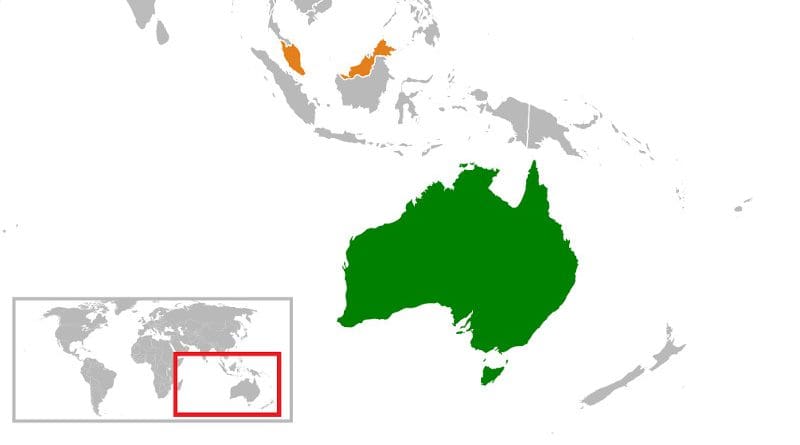Boosting The Australia–Malaysia Strategic Partnership – Analysis
By Adam Leong Kok Wey*
Against the background of the COVID-19 pandemic, Australia and Malaysia have elevated their strategic partnership by launching the Comprehensive Strategic Partnership (CSP) on 27 January 2021. Given the tenacious strategic context of Southeast Asia today, CSP defence cooperation has high potential spinoffs for Australia and Malaysia.
Australia’s defence cooperation with Malaysia has a long history. Australian forces fought against the Japanese forces in Malaya during the Second World War, conducted counter-insurgency operations during the Malayan Emergency (1948–1960) and defended Malaysia during the Indonesia–Malaysia Konfrontasi (1963–1966). Australian military presence in Malaysia continued with the start of the Five Powers Defence Arrangements (FPDA) in 1970.
During this period, Royal Australian Air Force combat aircraft were based in Butterworth. Under the FPDA platform, an Integrated Air Defence System was also set up to provide air defence radar coverage for Peninsular Malaysia and Singapore. Both Australia and Malaysia have frequently conducted joint military exercises, as well as cross posting of military officers within their respective military organisations.
Malaysia serves as an important forward basing location supporting Australia’s forward defence policy. Australia is a large continental island with a small population of about 25 million people. In defending its large territory, Australia prefers to deter and defeat threats at forward geographical locations, rather than doing so close to its shores.
Australia also has strong economic engagements with Southeast Asia. ASEAN is Australia’s second largest trading partner. Australia is also an active dialogue member of the ASEAN Defence Ministers’ Meeting Plus. Australia’s multilateral and bilateral relationships with Southeast Asia, especially with Malaysia, provides the backdrop to an important geographical bastion strategy to safeguard its national interests.
The CSP is also expected to benefit Malaysia in a number of ways. For a start, the presence of Australian troops and air power assets in Malaysia serves as an important deterrent for would-be aggressors. Although Malaysia has not experienced any foreign invasions since the Konfrontasi, the physical presence of Australian troops demonstrates Australia’s strong commitment to the FPDA. The joint training and cross posting of military officers from both countries also provides important experience and training for both militaries.
Malaysia may also benefit from intelligence sharing with Australia on key security issues. Australia is a member of the Five Eyes intelligence grouping with substantial capabilities and resources in intelligence gathering. Another key area for joint capability development is in cyber warfare. Under Australia’s 2020 Defence Strategic Update, Australia plans to spend AU$15 billion ($US 11.6 billion) over the next decade to upgrade its information and cyber capabilities. Similarly, Malaysia’s 2019 Defence White Paper stated that the Malaysian Armed Forces plans to develop cyber electromagnetic capabilities. Joint development, training and sharing of technology in the cyber domain between the two countries is a strategic possibility under the new CSP.
The Royal Australian Navy (RAN) has also deployed naval assets in the South China Sea to ensure the international ‘rules-based order’ is respected, the vision and values of which Malaysia shares. The Malaysian government has maintained that the overlapping claims in the South China Sea must be managed based on prevailing UNCLOS rules and international norms. In this sense, Australia’s support of the ‘rules-based order’ will enhance Malaysia’s own capacity to safeguard its territorial waters and exclusive economic zone. It will allow both countries to jointly monitor the South China Sea to prevent and deter behaviour by other countries that violates UNCLOS.
Malaysia has limited naval, coast guard and air assets to monitor the large swathes of maritime waters and quietly welcomes assistance from other friendly strategic partners. An incident last year highlights the importance of such naval cooperation. A Chinese government survey ship shadowed a Petronas (Malaysian state-owned oil company) contracted exploration ship for over 300 kilometres from the Malaysian coast between 15–28 April. The US Navy sent a small flotilla of combat vessels to the scene to monitor Chinese maritime operations, which were later joined by an RAN frigate, the HMAS Parramatta.
After spending a few days in the area, Chinese, US and Australian vessels quietly moved out, providing an uneventful ending to the standoff. Regardless, HMAS Parramatta’s rapid deployment illustrated the importance of Malaysia’s strategic partnership with Australia, especially in the naval domain.
There is significant potential for Australia and Malaysia to develop their strategic relationship through the CSP, with the agreement providing handsome strategic utility for both parties. Malaysia’s geographic location offers an advantage in supporting Australia’s forward defence strategy, while Australia provides Malaysia with latent strategic resources to augment its own limited defence capabilities. The two middle powers have shared strategic histories, values and regional security interests. The convergence of these interests signals that such strategic cooperation will surely continue and expand.
*About the author: Adam Leong Kok Wey is Associate Professor of Strategic Studies and Deputy Director of Research at the Centre for Defence and International Security Studies, the National Defence University of Malaysia.
Source: This article was published by East Asia Forum

